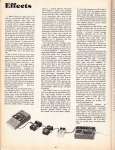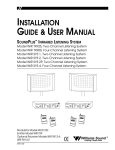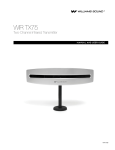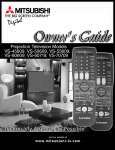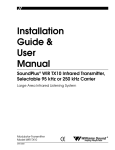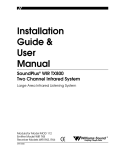Download Williams Sound SoundPlus Infrared System WIR SYS 90 PRO Installation guide
Transcript
INSTALLATION GUIDE & USER MANUAL Sound Plus™ Infrared Listening System Model WIR TX90, Two Channel System Model WIR SYS 90V, Two Channel System Model WIR SYS 90 PRO, Two Channel System Transmitter Model WIR TX90 Optional Receiver Models WIR RX22-4, WIR RX14-2, WIR RX18 Optional Charger Models CHG 518, CHG 3512 MAN 119E SOUNDPLUS™ INFRARED LISTENING SYSTEM, Model WIR TX90, Two-Channel Listening System Model WIR SYS 90V, Two-Channel Listening System Model WIR SYS PRO, Two-Channel Listening System INSTALLATION GUIDE & USER MANUAL CONTENTS PAGE System Overview . . . . . . . . . . . . . . . . . . . . . . . . . . . . . . . . . . . . . . . . . . . . . . . . . . . . . . . . 3 Installation Procedures Determining Coverage Area . . . . . . . . . . . . . . . . . . . . . . . . . . . . . . . . . . . . . . . . . . . . . .4 Connect Power . . . . . . . . . . . . . . . . . . . . . . . . . . . . . . . . . . . . . . . . . . . . . . . . . . . . . . . .6 Connect Audio Source . . . . . . . . . . . . . . . . . . . . . . . . . . . . . . . . . . . . . . . . . . . . . . . . . .7 Selecting a Frequency . . . . . . . . . . . . . . . . . . . . . . . . . . . . . . . . . . . . . . . . . . . . . . . . . .7 Select an Application Preset . . . . . . . . . . . . . . . . . . . . . . . . . . . . . . . . . . . . . . . . . . . . . .8 Adjusting Audio Inputs . . . . . . . . . . . . . . . . . . . . . . . . . . . . . . . . . . . . . . . . . . . . . . . . .8 Adjusting Tone . . . . . . . . . . . . . . . . . . . . . . . . . . . . . . . . . . . . . . . . . . . . . . . . . . . . . . . .8 Using the optional WIR TX9 Emitter for Additional Coverage . . . . . . . . . . . . . . . . . . . .9 Receiver Safety . . . . . . . . . . . . . . . . . . . . . . . . . . . . . . . . . . . . . . . . . . . . . . . . . . . . . . . . .10 Optional IR Receiver Instructions . . . . . . . . . . . . . . . . . . . . . . . . . . . . . . . . . . . . . . . . . .11 Trouble Shooting . . . . . . . . . . . . . . . . . . . . . . . . . . . . . . . . . . . . . . . . . . . . . . . . . . . . . . .13 Warranty . . . . . . . . . . . . . . . . . . . . . . . . . . . . . . . . . . . . . . . . . . . . . . . . . . . . . . . . . . . . . .14 Specifications . . . . . . . . . . . . . . . . . . . . . . . . . . . . . . . . . . . . . . . . . . . . . . . . . . . . . . . . . .15 2 SYSTEM OVERVIEW The WIR TX90 two channel infrared transmitter combines infrared modulator and emitter technology into a single mountable enclosure - reducing operating cost and eliminating precious rack space. The WIR TX90 features an easy to use configuration preset for Music, Voice, or Hearing Assistance Applications. It operates on dual 2.3/2.8 or 3.3/3.8 MHz selectable frequencies - ideal for high quality audio programs such as music, theater and audio description. The WIR TX90 will accept any line level, balanced or unbalanced audio inputs, and includes adjustable tone and volume control. Infrared receivers detect the transmission and convert the light signals back into audio signals. The 2.3-3.8 MHz operating frequencies minimize high efficiency lighting interference. No FCC license or radio approval is required with this equipment. It can be used anywhere in the world. NOTE: This equipment has been tested and found to comply with the limits for a Class A digital device, pursuant to part 15 of the FCC Rules. These limits are designed to provide reasonable protection against harmful interference when the equipment is operated in a commercial environment. This equipment generates, uses, and can radiate radio frequency energy and, if not installed and used in accordance with the instruction manual, may cause harmful interference to radio communications. Operation of this equipment in a residential area is likely to cause harmful interference in which case the user will be required to correct the interference at his own expense. NOTICE: A PLASMA MONITOR CAN DEGRADE THE AUDIO QUALITY OF THE WIR TX90 TRANSMITTER. FOR BEST PERFORMANCE, THE TRANSMITTER SHOULD BE POSITIONED AS FAR AWAY FROM THE PLASMA MONITOR AS POSSIBLE. FIGURE 1: TYPICAL TWO-CHANNEL CONFIGURATION FOR THE WIR TX90 3 u DETERMINE COVERAGE AREA Determine the coverage area needed for the seating area. When using the WIR TX90 transmitter with the RX22-4 receiver, in single channel mode, the WIR TX90 can achieve a coverage area of 28,000 ft2 (2,600 m2). In four channel mode, the WIR TX90 divides its power among the four signals to achieve a coverage area of 11,000 ft2 (1,022 m2). NOTE: The coverage area will vary depending on the sensitivity of the infrared receiver being used. The following diagram illustrates coverage area when using a RX224, RX14-2, or RX18 receiver with a single WIR TX90 transmitter in single channel mode. FIGURE 2: MAXIMUM RANGE WHEN USING THE RX22-4, RX14-2, OR RX18 RECEIVER These patterns are the direct radiation pattern. The infrared radiation does not drop to zero outside the illustrated patterns; it decreases. It still may be useable at a greater distance, depending on the receiver sensitivity and the reflective characteristics of the room. Reflections of the infrared light from walls, ceilings, and floors may change these patterns. Important: Remember to point the transmitter towards the listening audience! Remember: opaque objects block infrared light. Thus, the transmitter cannot be concealed behind opaque walls, curtains, etc. 4 FIGURE 3: 3 DIMENSION FOOT PATTERN FIGURE 5: OVERLAPPING ILLUMINATION FIGURE 4: NOTE: WHEN POINTING THE EMITTER, BE SURE TO KEEP THE LONG DIMENSION HORIZONTAL. PATTERNS TO COVER LARGER LISTENING WIR TX90 WIR TX9 WIR TX9 WIR TX9 FIGURE 6: OVERLAPPING ILLUMINATION PATTERNS TO COVER LARGER LISTENING AREAS AREAS Coverage Area with Single Transmitter WIR TX90 WIR TX9 Coverage Area with Second Emitter Added to Same Emission Point (50% increase) 5 FIGURE 7: WIR TX90 REAR VIEW Power Connection Plug in Power Supply 120 VAC (US): TFP 010 230 VAC (CE): TFP 027 Wall/Ceiling Mounting Bracket (BKT 024) Set of threaded holes for use with mounting bracket Baseband Out BNC Connector, 50 Ω 50 kHz-8 MHz Baseband u CONNECT POWER WARNING: POWERLINE VOLTAGE MUST NOT FALL BELOW 90V, 0R SYSTEM PERFORMANCE WILL BE GREATLY REDUCED! POWER CONNECTION FOR U.S. APPLICATION Connect the TFP 010 power supply to the 3-pin Molex™ connector located on the rear of the TX90 (see Figure 8, below). FOR APPLICATIONS OUTSIDE THE U.S. REQUIRING 240 VAC MAINS SUPPLY: Use the transformer power supply, model TFP 027. Make sure TFP 027 power input switch (located on bottom of power supply) is set to the “230” position. Secondary specifications: 24 VAC, 35 VA, 50/60 Hz. Plug the power supply into the AC outlet. TFP 027-01: 230VAC, Euro Mains Plug TFP 027-02: 230VAC, UK Mains Plug NOTE: The WIR TX90 transmits when a baseband signal is present, and will shut off immediately when no baseband signal is present. This auto shut-off feature preserves the life of the infrared LEDs and reduces power consumption. This system is designed for class 2, low-voltage wiring. Always follow local electrical codes when doing low voltage wiring. 6 FIGURE 8 Power In Jack u CONNECT AUDIO SOURCE Determine the length of the audio cable needed to connect to the sound system to the WIR TX90 transmitter. Install the supplied Phoenix connector on the end of the audio cable to be connected to the transmitter. See the back of the WIR TX90 for wiring instructions. FIGURE 9: AUDIO SOURCE CONNECTIONS The WIR TX90 will accept line level, balanced or unbalanced audio inputs. If you wish to operate in single channel mode, plug the audio cable with the installed Phoenix connector in “Channel A” OR the “Channel B” connector. If you choose to operate in two channel mode, plug the audio cables with Phoenix connectors in both “Channel A” AND “Channel B” connector. NOTE: By default, the WIR TX90 is set to operate in two-channel mode. To turn Channel A or Channel B on/off, refer to the instructions Selecting a Channel, below. FIGURE 10 Pow er no In dicator u SELECTING The WIR TX90 offers two sets of carrier frequencies for Channel A and Channel B: 2.3 and 2.8MHz or 3.3 and 3.8MHz. A CARRIER FREQUENCY PAIR The WIR TX90 is preset to 2.3 and 2.8 MHz, which are the most commonly used. Move the slide switch to select a pair of operating frequencies. u SELECTING CHANNEL To activate a channel, press the “CHANNEL” button until the channel “ON” indicator lights. For example, to operate only channel A, press the “CHANNEL” button until only the channel A “ON” indicator lights. To operate both channel A and B, press the “CHANNEL” button until both “ON” indicators light. A Note: If you’re only using one channel, make sure the other channel is turned off to maximize system coverage. 7 u SELECT AUDIO PROCESSING APPLICATION PRESET The WIR TX90 offers three preset audio processing options for the most common applications: Music, Voice, and Hearing Assist. Use the “Music” setting when maximum dynamic range and audio quality are preferred. Use the “Voice” setting for simultaneous interpretation, audio description, or other applications with users that have primarily normal hearing. Use the “Assist” setting for hearing assistance applications to meet the reduced dynamic range needs of hearing impaired listeners. You may select the same audio pre-set for both Channel A and Channel B, or you may select them independently. THE To select the audio processing preset, you must first activate the channel you want to adjust. Press the “channel” button to activate the channel(s) you want to choose an audio processing preset for, then press the “Presets” button to choose the preset. The Music, Voice, or Assist indicator will light to show your selection. After 10 seconds, the setting will be stored. u ADJUST AUDIO INPUT LEVEL The TX90 is designed to accept a line-level audio input signal. The “Level” indicator light for each channel is used to help adjust the audio input level. When the indicator does not light, the input signal level is too low. When the indicator is flashing, the signal level is optimal. When the indicator is steadily lit, but does not flash, the input level is too high and can cause distortion. You can adjust the input level of both channels simultaneously, or independently. Make sure the input audio signal is connected to the WIR TX90. To adjust the audio input level, first activate the channel(s) you want to adjust by pressing the “CHANNEL” button, then press the “VOLUME” button. The Volume indicator will light. Now, turn the “ADJUST” knob clockwise to increase the input signal or counter-clockwise to decrease the input signal until the channel “Level” indicator is flashing. After 10 seconds, the setting will be stored. IMPORTANT * * Audio level NORMAL (optimal): the audio indicator level will flash at a 1 second rate. Audio level too HIGH: the audio indicator level will stay on or flash erratically. Audio level too LOW: the audio indicator level will be off. ** u ADJUST TONE The WIR TX90 has a tone adjustment to suit user preference and to compensate for the different frequency responses of various infrared receiver models. First, make sure the audio source is active. Use a receiver from the system to listen to the signal as you adjust the tone control. To adjust the tone, first activate the channel(s) you want to adjust by pressing the “CHANNEL” button, then press the “TONE” button. The tone indicator will light. Now turn the “ADJUST” knob clockwise to emphasize high frequencies (best for hearing assistance use). When you have reached the maximum adjustment, there will be no further change in tone. Turn the “ADJUST” knob counter-clockwise to decrease the high frequency emphasis. When you have reached the minimum adjustment, there will be no further change in tone. After 10 seconds, the setting will be stored. 8 USING THE OPTIONAL WIR TX9 SLAVE EMITTER FOR ADDITIONAL COVERAGE For larger facilities, additional emitter panels can be used to increase the overall coverage area. In these cases, we recommend using the WIR TX9 slave emitter in tandem with the WIR TX90. The WIR TX90 can drive multiple WIR TX9 emitters at one time. Each TX9 emitter will require its own power supply. FIGURE 11: CONNECTING A WIR TX9 EMITTER TO A WIR TX9 Emitter (Rear) WIR TX90 TRANSMITTER WIR TX90 Transmitter (Rear) Baseband Input Baseband Output To TX9 Emitter To add a second WIR TX9 emitter panel to the WIR TX90 transmitter, repeat the process above (the WIR TX90 transmitter has two baseband output jacks). Note: The WIR TX9 emitter panels can be “chained” together if needed for unlimited coverage area. Each WIR TX9 emitter will require its own power supply. See Figure 12 below. FIGURE 12: CHAINING MULTIPLE WIR TX9 Emitter #2 (Rear) Baseband Output To additional Emitters WIR TX9 EMITTERS TOGETHER WIR TX9 Emitter #1 (Rear) Baseband Input Baseband Output To Second TX9 Emitter WIR TX90 Transmitter (Rear) Baseband Input Baseband Output To TX9 Emitter Baseband Output To Additional Emiters 9 RECEIVER SAFETY INFORMATION HEARING SAFETY Williams Sound receivers are designed to amplify sounds to a high volume level which could potentially cause hearing damage if used improperly. To protect your hearing and the hearing of others: CAUTION! 1. 2. 3. 4. BATTERY SAFETY Make sure the volume is turned down before putting on the earphone or headphone before adjusting the volume to a comfortable level. Set the volume level at the minimum setting that you need to hear. If you experience feedback (a squealing or howling sound), reduce the volume setting and move the microphone away from the earphone or headphone. Do not allow children o r o t h e r u n a u t h o r i z e d p e r s o n s to have access to the receiver. AND DISPOSAL Williams Sound receivers are supplied with disposable Alkaline batteries. Do not attempt to recharge disposable batteries, which may explode, release dangerous chemicals, cause burns, or other serious harm to the user or product. CAUTION! PACEMAKER SAFETY 1. Before using Williams Sound receivers with a pacemaker or other medical device, consult your physician or the manufacturer of your pacemaker or other medical device. CAUTION! 2. If you have a pacemaker or other medical device, make sure that you are using the Williams Sound receiver in accordance with safety guidelines established by your physician or the pacemaker manufacturer. RECYCLING INSTRUCTIONS BATTERY SAFETY Help Williams Sound protect the environment! Please take the time to dispose of your equipment properly. AND DISPOSAL P r od u c t R e c y c l i n g f o r C u s to m e r s i n th e Eu r op e an U n i o n : Please do NOT dispose of your Williams Sound equipment in the household trash. Please take the equipment to a electronics recycling center; OR return the product to the factory for proper disposal. Ba t t e r y R e c yc l i n g fo r C u st o me r s i n t h e E u r o p e a n U n i o n : Please do NOT dispose of used batteries in the household trash. Please take the batteries to a retail or community collection point for recycling. 11/20/07 10 OPTIONAL INFRARED RECEIVERS FIGURE 13: FOUR CHANNEL RECEIVER, MODEL WIR RX22-4 Channel 1 2 3 4 Frequency 2.3 MHz 2.8 MHz 3.3 MHz 3.8 MHz FIGURE 14: WIR RX14-2 HEADSET RECEIVER FIGURE 15: WIR RX18 UNDER-THE-CHIN RECEIVER WIR RX18 Front View 11 OPTIONAL CHARGERS FIGURE 16: MULTIPLE BATTERY CHARGER, MODEL CHG 518 CHG 518 Top CHG 518 Back FIGURE 17: MULTIPLE BATTERY CHARGER, MODEL CHG 3512 CHG WARNING: DO NOT ATTEMPT TO RECHARGE DISPOSABLE BATTER WARNING: IES! DO NOT CHG ATTEMPT TO RECHA RGE CHG Williams Sou nd DISPOSABLE BATTE RIES! CHG Williams Soun d CHG CHG CHG CHG CHG WARNING: DO NOT ATTEM PT TO RECHARGE DISPOSABLE BATTE CHG CHG RIES! WARNING: DO NOT ATTE MPT TO RECH ARGE DISPOSABL E BATTERIES ! CHG CHG 3512 Top 12 CHG 3512 Back TROUBLE SHOOTING THE WIR TX90 “POWER ON” INDICATOR IS NOT LIT. þ Make sure the transformer is plugged into the transmitter and any remote power switch is on. þ þ Make sure the electrical outlet is on. Make sure the 24 VAC power supply is working. THE WIR TX90’S CHANNEL A OR B “ON” INDICATOR IS NOT LIT. þ Make sure the desired audio channel has been activated. See Selecting a Channel on page 7. þ Make sure the WIR TX90 is plugged in. þ Make sure the audio input is connected properly. See page 6 or instructions on the back of the WIR TX90. þ Make sure an active audio signal is being sent to the WIR TX90 transmitter. NO SOUND THROUGH RECEIVERS. þ Check to make sure the receiver is operating on the same frequency as the transmitter. þ If some of the receivers work but others don’t, check for bad batteries or earphones on the receivers that aren’t working. þ If none of the receivers work, check to see if the power and audio input cable are connected to the transmitter and that the WIR TX90 “Power On” and Channel A or B “On” indicator is illuminated. þ Check to see if the transmitter is connected properly to the sound system. The audio level indicators should flash on channels that are selected. þ Make sure the “eye” is not covered up on the receiver. There must be clear line of sight between the receiver eye and the transmitter panel. SOUND THROUGH THE RECEIVERS IS WEAK AND NOISY. þ Listen to the audio signal through the headphone jack on the WIR TX90 transmitter (Figure 10). If the signal is weak and noisy here, try increasing the audio input level (see Adjust Audio Input Level, page 8), or increase the input signal level from the sound system by turning up the mixer control. If the signal sounds okay, you may need to reposition the transmitter panel or add additional IR emitters to the TX90 system. BUZZING OR HUMMING NOISE IN SOUND SYSTEM. þ Check for ground loops or noise on the input signal. Call your Authorized Williams Sound dealer or representative. NOTE: Make sure the powerline voltage does not fall below 90V, or system performance will be greatly reduced! 13 LIMITED WARRANTY Williams Sound products are engineered, designed, and manufactured under carefully controlled conditions to provide you with many years of reliable service. Williams Sound warrants the Sound Plus™ Infrared Listening System against defects in materials and workmanship for FIVE (5) years. During the first five years from the purchase date, we will promptly repair or replace the Sound Plus™ Infrared Listening System. Microphones, earphones, headphones, batteries, chargers, cables, carry cases, and all other accessory products carry a 90-day warranty. WILLIAMS SOUND HAS NO CONTROL OVER THE CONDITIONS UNDER WHICH THIS PRODUCT IS USED. WILLIAMS SOUND, THEREFORE, DISCLAIMS ALL WARRANTIES NOT SET FORTH ABOVE, BOTH EXPRESS AND IMPLIED, WITH RESPECT TO THE SOUND PLUS™ INFRARED LISTENING SYSTEM, INCLUDING BUT NOT LIMITED TO, ANY IMPLIED WARRANTY OF MERCHANTABILITY OR FITNESS FOR A PARTICULAR PURPOSE. WILLIAMS SOUND SHALL NOT BE LIABLE TO ANY PERSON OR ENTITY FOR ANY MEDICAL EXPENSES OR ANY DIRECT, INCIDENTAL OR CONSEQUENTIAL DAMAGES CAUSED BY ANY USE, DEFECT, FAILURE OR MALFUNCTIONING OF THE PRODUCT, WHETHER A CLAIM FOR SUCH DAMAGES IS BASED UPON WARRANTY, CONTRACT, TORT OR OTHERWISE, THE SOLE REMEDY FOR ANY DEFECT, FAILURE OR MALFUNCTION OF THE PRODUCTS REPLACEMENT OF THE PRODUCT. NO PERSON HAS ANY AUTHORITY TO BIND WILLIAMS SOUND TO ANY REPRESENTATION OR WARRANTY WITH RESPECT TO THE SOUND PLUS™ INFRARED LISTENING SYSTEM. UNAUTHORIZED REPAIRS OR MODIFICATIONS WILL VOID THE WARRANTY. The exclusions and limitations set out above are not intended to, and should not be construed so as to contravene mandatory provisions of applicable law. If any part or term of this Disclaimer of Warranty is held to be illegal, unenforceable, or in conflict with applicable law by a court of competent jurisdiction, the validity of the remaining portions of this Disclaimer of Warranty shall not be affected, and all rights and obligations shall be construed and enforced as if this Limited Warranty did not contain the particular part or term held to be invalid. If you experience difficulty with your system, call Toll-Free for customer Assistance: 1-800-843-3544 (U.S.A.) or +1 952 943 2252 (Outside the U.S.A.) If it is necessary to return the system for service, your Customer Service Representative will give you a Return Authorization Number (RA) and shipping instruction. Pack the system carefully and send it to: Williams Sound Corp. Attn: Repair Dept. 10321 West 70th Street Eden Prairie, MN 55344 USA Your warranty becomes effective the date you purchase your system. Your returned warranty card is our way of knowing when your warranty begins. It also gives us important information about your system including the serial number. This information will help us serve you better in the future. Please take a moment to complete and mail the attached card. Thank you. 14 SOUNDPLUS™ INFRARED LISTENING SYSTEM SPECIFICATIONS MODEL WIR TX90 INFRARED TRANSMITTER, MODEL WIR TX90 Dimensions, Weight: Color: Power Supply: Power Cable: Modulation: Carrier Frequency: Emitter IR Power: Coverage Area: Signal-to-Noise Ratio: Frequency Response: Total Harmonic Distortion: Compression: Auto Carrier Shut-Off: Power Indicator: Audio Volume Level Controls: Audio Indicators: Carrier LEDs: Phones Output: Application Preset: Tone Control: Power Input: Audio Input Connector: Input Level: Baseband Output: Baseband Cable: Operating Requirements: Mounting Kits: Warranty: Approvals: Compatible Receivers: Notes: 11.25" W x 6.25" H x 2.125" D (28.6 cm x 15.9 cm x 5.4 cm), 1.8 lbs (0.8 kg) Black with white legends, black acrylic lens Wall Transformer, 24 VAC, 50-60 Hz, 35 VA, 3-pin MOLEX Connector North America:TFP 010, UL/CSA TFP 027-01, 2-pin Schuko plug, CE Europe: UK: TFP 027-02, 3-pin UK plug, CE NEC Class 2 wiring, two-conductor, 18 ga., 200’ (61m) max. length FM Wideband, +50kHz deviation max., 50uS pre-emphasis Channel A: Selectable, 2.3/2.8 MHz, Channel B: Selectable, 3.3/3.8 MHz 3.5 watts Up to 28,000 ft2 (2,600 m2) in single-channel mode when using the RX22-4 Receiver Up to 18,000 ft2 (1,670 m2) in four-channel mode when using the RX22-4 Receiver Up to 3,500 ft2 (325 m2) in single-channel mode when using the RX14-2 Receiver Up to 3,063 ft2 (285 m2) in single-channel mode when using the RX18 Receiver (See coverage area diagrams) >75 dB, +3dB 80 to 15,000 Hz, electrical response Less than .2%, electrical response at 1kHz Music preset 1:1, Voice preset 1.5:1, Hearing Assist preset 2:1 20 minute timer shuts off carrier when no audio is present Red LED CHA and CHB Input Level, press to select, 28 dB adjustable range CHA and CHB Audio Level, yellow LED, flash 2 green LED carrier “on” indicators 3.5mm TRS headphone jack. CH A tip, CH B ring on jack, 32 ohm headphone (min) Music, Voice, Hearing Assist. Frequency response; Music: Flat; Voice: Mid-range boost; Hearing Assist: High frequency boost Press to select, 21 dB adjustable range (1 kHz between low boost/hi-cut and low cut/hi boost). 3-Pin Molex, 24 VAC, 50-60 Hz, 35 VA CHA and CHB, 3 wire Phoenix Balanced or unbalanced, 316 mVRMS (-10dBV) nominal, 5.7k input impedance; max input (over volume range) -21 to +7 dBV. BNC, 50 Ω, for use with TX9 only RG 58 Coax, BNC connectors, maximum 1000’ (300m) length 0-50º C (+32°F to 122°F) ambient temperature, non-condensing, non-corrosive atmosphere Wall or Ceiling Mount: BKT 024 Omnidirectional mount; Optional: Mic Stand Kit: SS-10; or Tripod Stands: SS-11 or SS-6 5 years on transmitter, 90 days on accessories CE, FCC, RoHS, WEEE WIR RX22-4 Four-Channel Receiver, WIR RX22-4 Four-Channel Receiver, WIR RX14-2 TwoChannel Receiver, WIR RX18 Two-Channel Receiver Specifications: Single end input, volume & tone controls at mid point, 1 kHz, “Music” Preset Visit our website for the latest specifications and publications: www.williamssound.com NOTE: Specifications subject to change without notice. 15 ® 10321 West 70th St., Eden Prairie, MN 55344 U.S.A. 800.843.3544 | 952.943.2252 | FAX: 952.943.2174 www.williamssound.com ©2010, Williams Sound Corp. MAN 119E

















